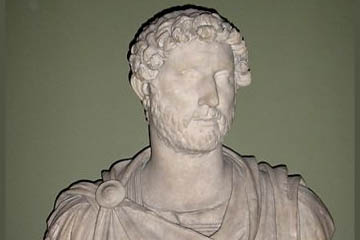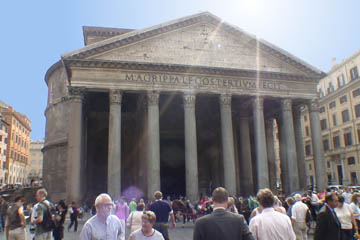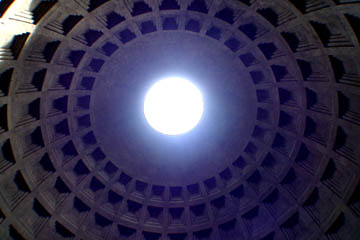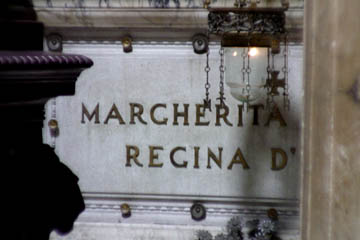Hadrian's Monument and the Pizza
Visitors to Rome have no lack of ruins over which to marvel. Hot, foot-sore and weary, they stumble through the shattered stones of the Forum, circle the floorless arena of the Colosseum, gawp at the crumbling arches of the baths of Trajan and peer in vague incomprehension at the blocks of brickwork that are all that is left of the great palaces on the Palatine. In all this mass of broken, decaying grandeur there is only one building that survives in pristine condition - the Pantheon.
Its survival, of course, is due to the fact that whereas other buildings were considered redundant and stripped of their marble facings and lead roofs, the Pantheon was consecrated as a Christian church and so remained in constant use - and equally constant repair - through the centuries.
Few, however, of the crowds of tourists that throng its circular floor are aware of the story behind the building and, if our experience is anything to go by, even the guides are equally ignorant. (It is possible, of course, that they do know the story but simply do not tell it. Your average licenced guide has had all the excitement and romance of archaeology trained out of him - or her - and all that is left is a dull recitation of dates and facts.)

Six years after the fall of Jerusalem in AD 70, a boy was born in Rome and given the name Publius Aelius Hadrianus. There were about a dozen boys' names used in ancient Rome and Publius was one of them; the family name which the baby inherited was Aelius. Onto this was tacked a nickname, which in this case was a reference to the ancestral home of the Aelius family, the town of Hadria at the mouth of the river Po (a port city which gave its name to the entire sea - the Adriatic!)
When Publius Aelius Hadrianus was nine his father died and two guardians were appointed to oversee his upbringing. One of them, his father's cousin, was called Marcus Ulpius Traianus and twelve years later he unexpectedly had the chance to become emperor when Domitian, the paranoid maniac, was assassinated. Nerva, an elderly senator, was chosen to replace him and he in turn picked Traianus to be his successor and formally adopted him.
Traianus, better known to us as Trajan, duly succeeded to the imperial throne and invited his ward to become part of his entourage. Some suggest that this was because young Publius had a phenomenal capacity for drink and could match Trajan cup for cup; I prefer to think that it was because Trajan recognised the young man's potential.
Publius aspired to be what we today would call "a Renaissance man" - someone who knew something about everything and everything about most things. His contemporaries commented on his "childish" curiosity: Tertullian, the Christian apologist, speaks of him as "an investigator of everything strange" while Suetonius remarks on his ability "to recite from memory books that he had just read, even ones that most people had never heard of".
Allied to this mental ability was his drive to excel, which led him to be a reckless huntsman and soldier (though not a reckless general). Though he did his best to be pleasant and diplomatic to all, another biographer alleges that "he cleverly concealed a temperament which was jealous, harsh, libidinous and fixated on showing off. Instead he affected self-control, pleasant manners and kindness, and kept in check the passion for sucess which was his dominant feeling."
Among the many accomplishments attributed to him are singing, medicine, music, geometry, painting, sculpture in bronze and stone, and architecture. It was in this latter field that he really let his imagination run free.
The buildings of previous civilisations had been held together with lime plaster which served to strengthen the joints between bricks or blocks of stone that were already fixed in place by gravity and mass. The Romans, however, invented a form of cement which allowed them to actually glue bricks together. The result was the ability to construct huge arches and vaults which were beyond the conception of previous architects.
Publius was intrigued by these new techniques and passed many a pleasant hour dreaming up and sketching buildings whose roofs swooped and soared in curves and domes. Unfortunately the professional architects of the time were suspicious of these radical new designs and one of them, the famous Greek architect Apollodorus of Damascus, snubbed the young man quite severely.
Trajan was discussing a building project with Apollodorus when Publius joined them and expressed an opinion which contradicted the advice Apollodorus was giving. Apollodorus fixed him with a baleful eye and snapped, "Go and draw pumpkins, young man. You don't understand this sort of thing."
Bitterly offended at having his curves dismissed as mere "pumpkins", Publius stalked off, but the architect's words rankled and were not forgotten.
When Trajan died in August 117 AD, worn out by a campaign against the Parthians which had taken him to the shores of the Persian Gulf, Publius was lucky enough to be on the spot. Even luckier, the dying emperor had been attended by two women, his wife Plotina - who had long been Publius' friend - and his niece Matidia, who was Publius' mother-in-law. They announced that on his death bed the 70-year old Trajan had adopted Publius as his son and heir. Publius Aelius Hadrianus became the Emperor Hadrian.
Early in 118 AD Hadrian led his troops into Rome and set about making his position secure. One of his first actions was to set his mark on the city by a grandiose building project, an enormous temple to the goddesses Venus and Roma, both associated with the city of Rome. The only site he could find for such a huge building was already occupied by a 100' high statue of Nero as the sun god. In a flambouyant gesture, Hadrian had a team of twenty-four elephants drag the statue to a new location near the vast amphitheatre built by Vespasian, quite unintentionally giving that structure the name by which it has been known ever since - the Colosseum, named not for its own size but for the colossal statue of Nero!
Hadrian himself drew up the designs for the temple and, perhaps to show that he was not just a dreamer of "pumpkins", designed a perfectly ordinary temple with colonnades and a sloping roof. Then, in a graceful gesture of appeasement, he sent the plans to Apollodorus for his approval. The crusty old architect was not mollified: there was nothing he could fault in the actual design of the temple, but he sent back a curt reply, pointing out that the proportions of the temple were entirely wrong for the planned statues of the seated goddesses, for if they were to stand up, their heads would go through the ceiling. Infuriated by this rebuff - for the statue of Zeus at Olympia, one of the Seven Wonders of the World, was also far too large to stand up in its temple - Hadrian forgot all about his peace-making and ordered the execution of Apollodorus.
Hadrian then turned his attention to building a summer retreat for himself, not down at popular Baiae - perhaps he was nervous about getting too close to Vesuvius! - but in the hills twelve miles outside Rome. The palace that he built at Tivoli was not only the largest private residence in the world - its "simple" character underlined by being called a villa instead of a palace - but it gave Hadrian the chance to experiment with vaults and complex shapes to his heart's content.

Then, finally, he was ready for his masterpiece. A Pantheon, a temple for all the gods, was built in the time of Augustus in the form of a circular colonnade so that no one god would have precedence. (King Arthur's Round Table was designed with a similar aim of equality.) Hadrian followed his example, but with one important difference: his Pantheon would have a roof.
Whether Hadrian had any professional architects as advisers and consultants, we do not know. Personally I rather doubt it. Such people are far too fond of telling you that as something has never been done before, it can't be done now. His design was based on the sphere, the most perfect of all the shapes; however instead of a ball-shaped lower half, the upper half of the sphere was supported by a circle of wall, resulting in a huge circular building whose interior was simply empty floor space: no pillars or piers supporting the roof.
There was just one curious feature: at the highest point of the sphere there was a large circular opening in the roof, most inconvenient as far as the priests were concerned, for it let in the sun in summer and the rain and snow in winter. In fact, special drains had to be constructed in the floor to cope with the amount of water that fell inside the building.

Guides will tell you that the opening or oculus was intended to let in light. The more imaginative assert that it was designed so that the rays of the sun could strike this particular point or trace that particular path. Mystics claim that it was built because some gods could only be worshipped in the open air.
Personally I think it had an entirely different purpose. A dome, when you think about it, is nothing more than an arch turned through 360 degrees. The most important feature of an arch is the keystone; take that away and the arch collapses in ruin. Hadrian, in order to demonstrate his mastery of architecture, built his dome without a keystone!
The ironic thing is that only another architect could have appreciated the difficulty of such a construction - and by then the only architect whom Hadrian really wanted to impress was long dead, killed by imperial decree. I wonder whether he regretted his fit of bad temper?
The fact is that the radical innovation of the Pantheon had a tremendous impact on architecture. When Justinian wanted to show that Christian New Rome was better than pagan Old Rome, he constructed an even bigger dome - built, this time, on a square base rather than a circular one - in the marvellous church of Haghia Sophia. When the Turks captured Byzantium they wanted to show that Islam could achieve even greater things and built the even larger Blue Mosque.
It is ironic to think that the domed roof of St Paul's in London and the domed mosques that dot the Middle East all owe their origin to a pagan emperor and a pagan temple. It is even more ironic to think that Hadrian's design for a pan-theon, a temple of all the gods, is now being used so freely by two religions whose fundamental tenet is mono-theism.
In front of the temple Hadrian built an entirely conventional portico, supported on pillars made from single blocks of granite brought all the way from Egypt at enormous expense. Across the front of the portico Hadrian had an inscription carved, implying that the building had been erected by Agrippa, Augustus' son-in-law, who had erected the first temple to all the gods on the site.

Today the Pantheon is, as I have already mentioned, a Christian church and the last resting place of several of the kings of modern Italy. Their massive monuments disfigure the grand simplicity of Hadrian's wonderful building, so perhaps it is fitting that tourists, to whom the names of Victor Emmanuals I, II and III mean nothing, are far more interested in a plaque on the wall that commemorates one of their queens.
Whether she would be entirely pleased by their attention I am not sure. You see, no one is interested in the children she bore or the talents she possessed nor even in whatever charities she patronised. She is famous for one thing and one thing only: when she visited Naples the cooks of that town devised a new type of pizza in her honour and named it after her. Margherita.
© Kendall K. Down 2009





